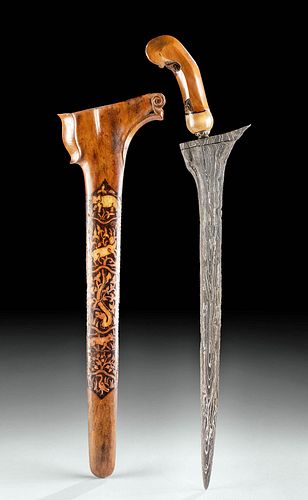Early 20th C. Indonesian Wood, Stone, & Iron Kris
Lot 46b
About Seller
Artemis Gallery
686 S Taylor Ave, Ste 106
Louisville, CO 80027
United States
Selling antiquities, ancient and ethnographic art online since 1993, Artemis Gallery specializes in Classical Antiquities (Egyptian, Greek, Roman, Near Eastern), Asian, Pre-Columbian, African / Tribal / Oceanographic art. Our extensive inventory includes pottery, stone, metal, wood, glass and textil...Read more
Categories
Estimate:
$800 - $1,200
Absentee vs Live bid
Two ways to bid:
- Leave a max absentee bid and the platform will bid on your behalf up to your maximum bid during the live auction.
- Bid live during the auction and your bids will be submitted real-time to the auctioneer.
Bid Increments
| Price | Bid Increment |
|---|---|
| $0 | $25 |
| $300 | $50 |
| $1,000 | $100 |
| $2,000 | $250 |
| $5,000 | $500 |
| $10,000 | $1,000 |
| $20,000 | $2,500 |
| $50,000 | $5,000 |
| $100,000 | $10,000 |
| $200,000 | $20,000 |
About Auction
By Artemis Gallery
Jun 24, 2021
Set Reminder
2021-06-24 10:00:00
2021-06-24 10:00:00
America/New_York
Bidsquare
Bidsquare : VARIETY SALE | Ancient & Ethnographic Art
https://www.bidsquare.com/auctions/artemis-gallery/variety-sale-ancient-ethnographic-art-7119
Featuring classical antiquities, ancient and ethnographic art. Egyptian, Greek, Roman, Etruscan, Near Eastern, Asian, Pre-Columbian, Native American, African / Tribal, Oceanic, Spanish Colonial, Russian, Fossils, Fine Art, more! All legally acquired, legal to sell. Satisfaction guaranteed. Artemis Gallery info@artemisgallery.com
Featuring classical antiquities, ancient and ethnographic art. Egyptian, Greek, Roman, Etruscan, Near Eastern, Asian, Pre-Columbian, Native American, African / Tribal, Oceanic, Spanish Colonial, Russian, Fossils, Fine Art, more! All legally acquired, legal to sell. Satisfaction guaranteed. Artemis Gallery info@artemisgallery.com
- Lot Description
Southeast Asia, Indonesia, ca. early to mid 20th century CE. A beautiful example of a kris (keris), a type of personal ceremonial sword. The hand-carved wooden handle depicts a pair of abstract face maskettes along the interior curve and a hemispherical, butterscotch-hued stone adornment between the handle and the top of the blade. Decorated with silvery swirls atop charcoal grey, the forged-iron blade has a gentle serpentine profile and a projecting hand guard. Alternatively, the wooden sheath boasts a lustrous shade of caramel, a wide guard protector with a decorative volute at its end, and a gorgeous inlaid wood decoration in tones of chocolate brown and cream displaying an intricate vegetal motif with the forms of an elephant, a goat, a snake, a wolf or feline, and crane. A fabulous example from Indonesia! Size of blade: 14.5" L x 3" W (36.8 cm x 7.6 cm); Size in sheath: 19.5" L x 4.5" W (49.5 cm x 11.4 cm)
The kris is both a weapon and a spiritual object. The oldest known are from the 10th century CE; they are thought to have originated on the island of Java. The bladesmith, called an empu, formed the blade from layers of different iron ores and meteorite nickel. In high quality ones, the metal is folded dozens or even hundreds of times. Traditionally, krises were worn every day as well as for special ceremonies; both men and women wore them. They were passed down through families. They were also used for display, as talismans with magical powers, weapons, heirlooms, accessories for ceremonial dress, and indicators of social status.
Provenance: private Rochester, Michigan, USA collection
All items legal to buy/sell under U.S. Statute covering cultural patrimony Code 2600, CHAPTER 14, and are guaranteed to be as described or your money back.
A Certificate of Authenticity will accompany all winning bids.
We ship worldwide and handle all shipping in-house for your convenience.
#137993Losses to inlaid wood on sheath. Nicks to periphery of blade. Abrasions and scratches to sheath. Otherwise, excellent with light earthen deposits in recessed areas.Condition
- Shipping Info
-
All shipping is handled in-house for your convenience. Your invoice from Artemis Gallery will include shipping calculation instructions. If in doubt, please inquire BEFORE bidding for estimated shipping costs for individual items.
-
- Buyer's Premium



 EUR
EUR CAD
CAD AUD
AUD GBP
GBP MXN
MXN HKD
HKD CNY
CNY MYR
MYR SEK
SEK SGD
SGD CHF
CHF THB
THB













